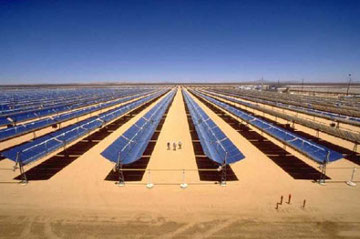Concentrated solar power projects moving ahead in California

Two major concentrated solar power (CSP) projects in California received major funding from the Department of Energy last week while a third got a go-ahead after determining a plan to ensure that desert tortoises will not be threatened.
CSP reflects the heat of the sun to a small area where is it used to heat fluids or create steam which then powers turbines to generate electricity. Traditional CSP uses wet cooling, which means it gets a steady supply of fresh water. This procedure is cost-effective but obviously highly controversial, especially in deserts where water is scarce and the water wars are already fierce. Thus, many CSP projects are mandated to use dry-cooling which reuses water as much as possible and can cut water usage up to 90%.
The Mojave Solar Project and the Genesis Solar Project received a total of $1.9 billion in loan guarantees last week from the Department of Energy. These projects, when completed, will generate 250 MW each. The Mojave Solar Project got $1.2 billion in guarantees. It uses the heat of the sun only and does not have backup natural gas power.
The Genesis Solar Project near Blythe received $681 million in guarantees. While originally wet-cooling, it has apparently switched to dry-cooling and will use 202 acre feet a year (enough for 550 homes) from onsite wells which, since the water might be from Colorado River aquifers, is the subject of a lawsuit.
The Ivanpah Project near Primm NV got $1.6 billion in guarantees awhile back and just received permission from the Bureau of Land Management to continue after the project was halted due to finding far more desert tortoises than expected. The new plan for tortoise mitigation requires them to buy additional land for relocation, monitoring them for five years, and more. At times, they have over 100 biologists onsite monitoring the tortoises and it has cost them a "surprising amount of money." Ivanpah will generate 392 MW when finished and uses dry-cooling.
CSP in deserts takes large amounts of land. Between them, these three projects will use 12 square miles. However, this is probably smaller than land use by hydropower or coal, when you factor in the size of the reservoir behind the dam or land destroyed by mining coal. As always, water is a key issue. For CSP to be successful in California, it needs to use as little water as possible. What we are seeing now in the Mojave is just the beginning. If these CSP plants are economically successful (and how can they not be with California mandating 33% renewable energy use by 2020?), then many more will follow. What the long-term effect on the Mojave or water supplies will be if, say, dozens of CSP plants are sited there is not known.
The combined power output, when completed, of all approved big solar projects in deserts in California now (including the three mentioned here), is 4192 MW or about 4.2 GW. That's about the size of one big nuclear plant or two big coal plants. On a nice June day, California uses about 702,000 MWh with renewable energy generation being about 13% of that. We have a long ways to go and a short time to get to that 33% goal.



